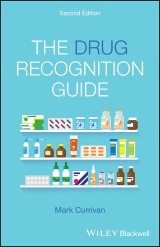Details

The Drug Recognition Guide
2. Aufl.
|
25,99 € |
|
| Verlag: | Wiley-Blackwell |
| Format: | EPUB |
| Veröffentl.: | 26.03.2021 |
| ISBN/EAN: | 9781119689850 |
| Sprache: | englisch |
| Anzahl Seiten: | 128 |
DRM-geschütztes eBook, Sie benötigen z.B. Adobe Digital Editions und eine Adobe ID zum Lesen.
Beschreibungen
<p><i>The Drug Recognition Guide</i> introduces an innovative method for recognising and categorising medications, enabling readers to easily identify the type and use of a generic drug by visually deconstructing its name. Through its creative use of colour-coded drug prefixes and suffixes, this pocket-sized guide makes generic drug names distinctive, logical, and easy to pronounce and remember. More than 700 drugs from over 200 different drug categories are catalogued and colour-highlighted—helping you understand what underlies a generic drug name.</p> <p>Organised by class and use, the book's ten chapters cover a comprehensive range of drugs, including chemotherapy and immunosuppressants, drugs that affect the cardiovascular and respiratory systems, drugs used to manage pain, treat infectious diseases, and many others. Each entry briefly summarises a particular class of drugs, describes the intended use of drugs within the class, and breaks down the “name stems” of individual drugs to reveal useful information and illustrate connections between chemically and therapeutically related medicines.</p> <p>Presenting an original, easy-to-use approach to the complex subject of drug classification, this invaluable learning aid:</p> <ul> <li>Provides a thorough yet accessible way for students and practitioners to increase their understanding of medications and their application</li> <li>Helps students to clearly read and pronounce even the most difficult generic drug names</li> <li>Highlights the letters in generic drug names to enable students to recognise drugs immediately</li> <li>Explains who assigns a generic drug name and what the name represents</li> <li>Includes an introduction to generic and proprietary drug names and design motifs</li> </ul> <p><i>The Drug Recognition Guide</i> is essential reading for nursing and medical students, pharmacy students and technicians, as well as nurse practitioners and trainee and junior doctors.</p>
<p>Foreword ix</p> <p>Introduction xi</p> <p>1 Drugs that affect the gastrointestinal system 1</p> <p>2 Drugs that affect the cardiovascular system 7</p> <p>3 Drugs that affect blood coagulation and lipids 21</p> <p>4 Drugs that affect the respiratory system 31</p> <p>5 Drugs that affect the central and peripheral nervous system 35</p> <p>6 Drugs used in the management of pain 51</p> <p>7 Antiemetics: drugs used in the management of nausea and vomiting 59</p> <p>8 Diabetes drug therapy and other medicines that affect the endocrine system 65</p> <p>9 Antimicrobials: drugs used to treat infectious diseases 77</p> <p>10 Chemotherapy and immunomodulating agents 89</p> <p>Index of Drugs Groups 99</p> <p>Index of Drugs 105</p>
<p><b>Mark Currivan</b> is Senior Staff Nurse, Medication Competency Assessor, and former Practice Development Leader at Wirral University Teaching Hospital, UK. He is a regular guest lecturer on medicines management at the University of Liverpool for the Bachelor of Nursing Programme, and has played an important part in advancing nursing curriculum development around safe medicine administration to meet the Nursing and Midwifery Council’s Standards of Proficiency for Registered Nurses.</p>
<p><i>The Drug Recognition Guide</i> introduces an innovative method for recognising and categorising medications, enabling readers to easily identify the type and use of a generic drug by visually deconstructing its name. Through its creative use of colour-coded drug prefixes and suffixes, this pocket-sized guide makes generic drug names distinctive, logical, and easy to pronounce and remember. More than 700 drugs from over 200 different drug categories are catalogued and colour-highlighted—helping you understand what underlies a generic drug name.</p><p>Organised by class and use, the book’s ten chapters cover a comprehensive range of drugs, including chemotherapy and immunosuppressants, drugs that affect the cardiovascular and respiratory systems, drugs used to manage pain, treat infectious diseases, and many others. Each entry briefly summarises a particular class of drugs, describes the intended use of drugs within the class, and breaks down the “name stems” of individual drugs to reveal useful information and illustrate connections between chemically and therapeutically related medicines.</p><p>Presenting an original, easy-to-use approach to the complex subject of drug classification, this invaluable learning aid:</p><li><bl>Provides a thorough yet accessible way for students and practitioners to increase their understanding of medications and their application</bl></li><li><bl>Helps students to clearly read and pronounce even the most difficult generic drug names</bl></li><li><bl>Highlights the letters in generic drug names to enable students to recognise drugs immediately</bl></li><li><bl>Explains who assigns a generic drug name and what the name represents</bl></li><li><bl>Includes an introduction to generic and proprietary drug names and design motifs</bl></li><p><i>The Drug Recognition Guide</i> is essential reading for nursing and medical students, pharmacy students and technicians, as well as nurse practitioners and trainee and junior doctors.</p>


















